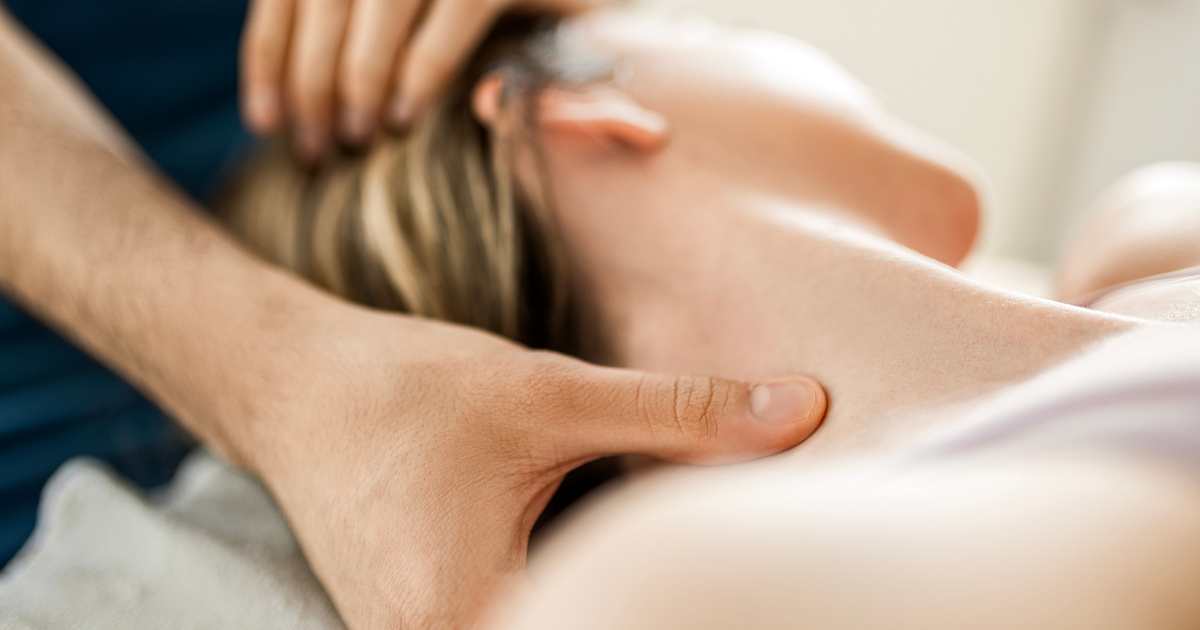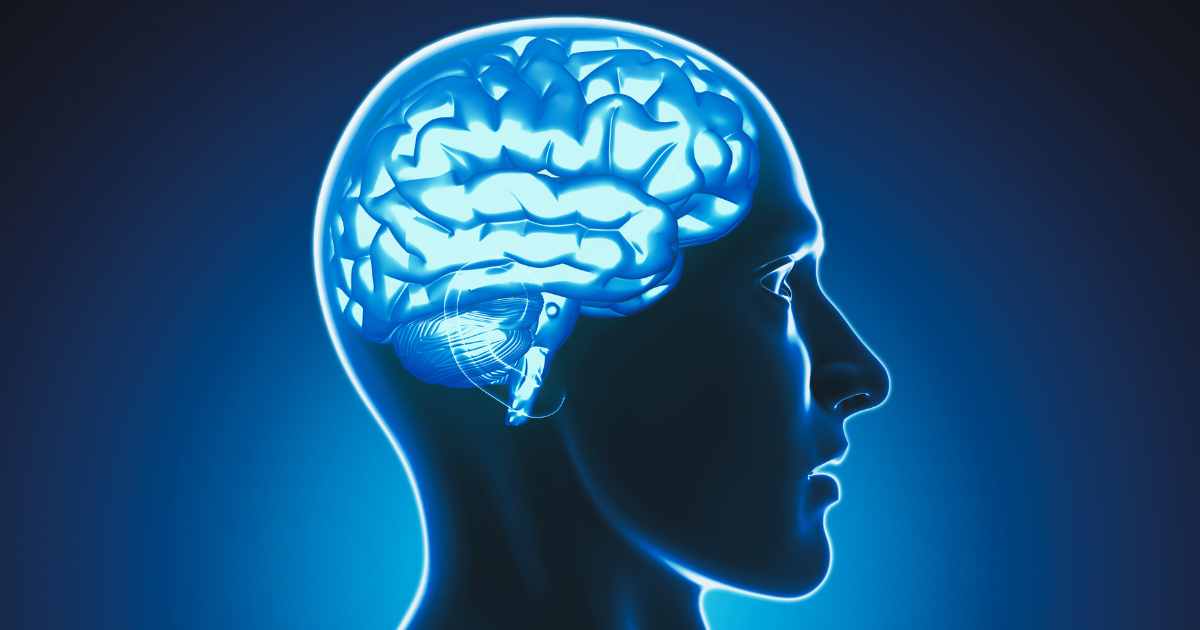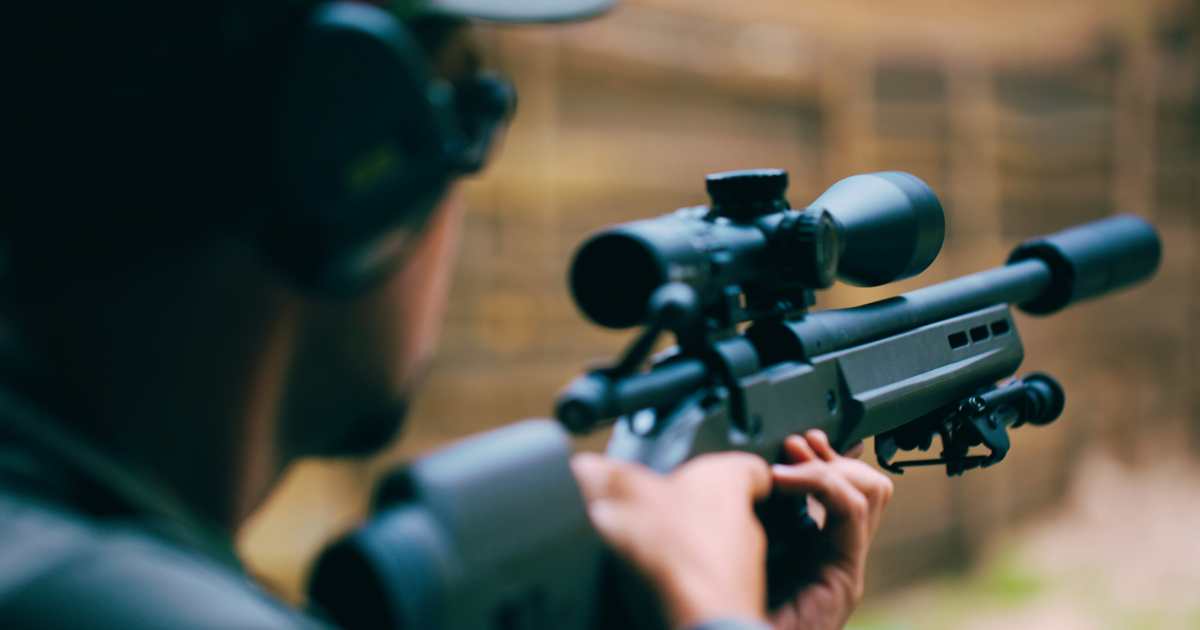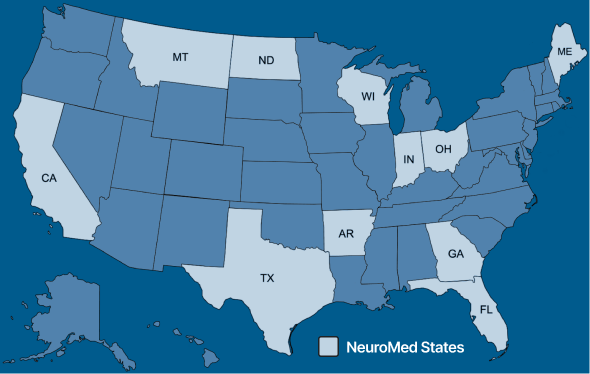MD Reviews Sound Therapy Tinnitus Options
Everyone with clinically significant tinnitus needs to know about sound therapy treatment options. Here I cover the following important topics about sound therapy for tinnitus:
- Does everyone have tinnitus in silence?
- What causes tinnitus in the brain?
- What is sound therapy for tinnitus?
- What are the best tinnitus therapy sounds?
- How often should you use sound therapy for tinnitus?
- What is tinnitus masking?
- What is Tinnitus Retraining Therapy?
- What is bimodal stimulation for tinnitus?
- Can sound therapy cure tinnitus?
Intro to Tinnitus Treatment With Sound Therapy
Sound therapy for tinnitus is one of the most effective front-line treatments for tinnitus. However, despite being around for 200 years, no single sound therapy technique has emerged as the standard of care.
Because there are huge variations in how tinnitus symptoms affect each individual, the most effective form of sound therapy for tinnitus depends on personal preference. Think of it like meditation. We know meditation therapy helps relieve tinnitus symptoms, but there are many different forms of meditation and no single technique is best for everyone.
The important thing is that for ringing in the ears, sound therapy treatments consistently show positive results and they should be part of any comprehensive tinnitus rehabilitation strategy. Here, I’ll explain the basics of why sound therapy works for tinnitus and the different kinds of sound therapy modalities available, including tinnitus masking devices and tinnitus retraining therapy.
Does everyone have tinnitus in silence?
The surprising answer is yes, the majority of people will experience ear ringing in silence (in some studies, up to 94%), even if they have completely normal hearing [1]. Now keep in mind that these people do not have what we think of as tinnitus per se, where the ear ringing becomes bothersome, intrusive, and burdensome.
So if people without tinnitus will hear ringing in their ears in a quiet environment, what happens to people with tinnitus when it’s quiet? As you can probably guess, quiet almost universally makes tinnitus symptoms louder and more bothersome.
What causes ringing in ears when it’s quiet?
Tinnitus can seem louder in quiet environments due to a phenomenon known as “contrast-induced hyperactivity.” In a quiet setting, there is less external ambient noise to mask (cover up) the internal sounds associated with tinnitus. This lack of external sound allows the perceived volume of the tinnitus sounds to seem louder.
Suppose you’re looking at a candle in a dark room. In the darkness, the candle appears very bright. However, when the lights are one, the brightness of the candle decreases. The candle light hasn’t changed. However, the brain signals produced from the candle light become diminished relative to all of the new stimulus when the light is turned on.

Several other factors contribute to tinnitus loudness in quiet, including:
• Lack of Stimulus: Background noise in a bustling environment can act as a form of masking, helping to cover up or drown out the internal sounds associated with tinnitus. In a quiet room, this masking effect is diminished, making the tinnitus more apparent.
• Increased Sensitivity: When external sounds are minimal, the brain’s sensitivity to internal signals, such as those associated with tinnitus, can increase. The lack of competing stimuli may make the tinnitus more noticeable and seem louder.
• Auditory System Amplification: In the absence of external stimuli, the auditory system may become more sensitive to internal signals, including the neural activity associated with tinnitus loudness. This heightened sensitivity can contribute to the perception of increased loudness.
• Psychological Factors: The quietness of the environment can also lead to increased attention and focus on internal sensations, including tinnitus. This heightened awareness may make the tinnitus symptoms seem more prominent.
While tinnitus symptoms can seem more noticeable in quiet settings, the perceived loudness can vary among individuals. As you can guess, this principle is important in establishing how sound therapy for tinnitus works.
Why is my tinnitus worse at night?
In the quiet of night, the brain tends to focus on the neural signals that are present. Since with tinnitus there is a heightened activity of auditory neurons, the brain will focus on the signals of these hyperactive neurons, making ear ringing worse at night. This is sometimes referred to as “bedtime tinnitus”.
Just like in quiet, tinnitus symptoms are worse at night because of a lack of other stimuli, increased sensitivity to loud noises, auditory system amplification, and psychological factors.
"I learned more about my tinnitus in the intro call than from my doctor..."
– Alice Lee

Ready for relief? NeuroMed can help.
What causes tinnitus in the brain?
Focussing on just the auditory system, tinnitus is caused by increase in electrical activity (hyperactivity) of nerve cells in the hearing part of the brain (auditory neurons) secondary to damage to the inner ear.
When you lose hearing, you lose the hearing cells in the inner ear, but the brain cells that do the function of hearing don’t die and in fact get more excitable and active because they don’t get a signal from the ear. That excitability and increase in activity is what tinnitus is. The rest of the brain sees that there is increased activity in the hearing part of the brain and says, “there must be some sound around” and you hear it as a ringing, hissing, buzzing, etc.
The cochlea, the snail shaped structure in the inner ear, works by translating sound waves into nerve signals through “hair cells” (they have delicate hair-like structures). Over time with aging, or secondary to trauma from noise, infections, or other causes, these hair cells become damaged and even die, resulting in hearing loss at that specific frequency.
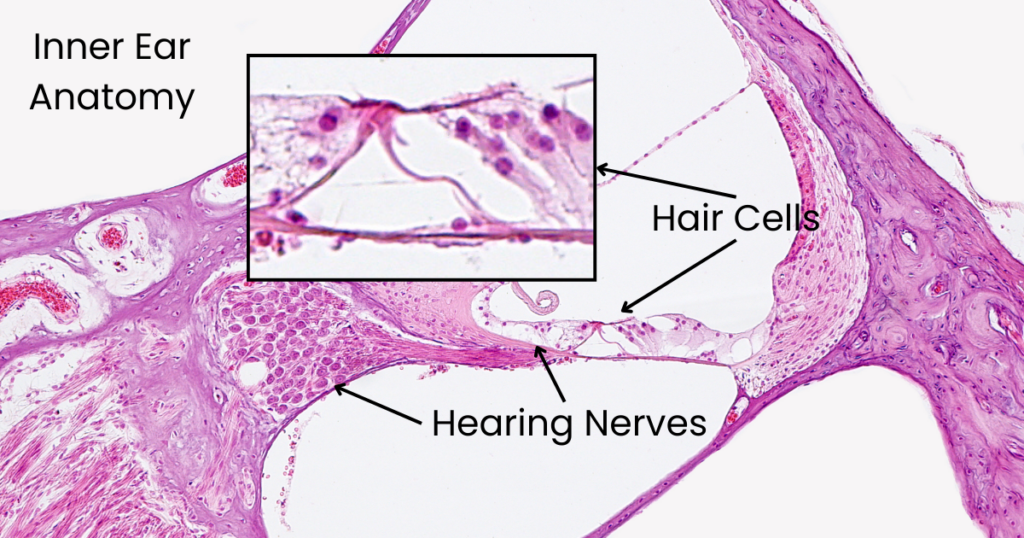
However, when these hair cells die, the nerve cells that were attached to them are still very much alive. In fact, become more active, even hyperactive. In fact, we hear tinnitus sounds in the region where we actually lost hearing due to hair cell damage.
The location of the damaged hair cell corresponds to the tone of the ringing. Ringing and hissing tinnitus correspond to hearing loss in high pitches (frequencies), and buzzing or humming tinnitus corresponds to hearing loss in lower pitches (frequencies).
Beyond the auditory system, there are multiple causes and associations that may contribute to tinnitus loudness.
What is sound therapy for tinnitus?
Because we know that ear ringing is worse when it’s quiet, sound therapy for tinnitus uses external or ambient sounds to provide relief by masking or distracting from the internal noise. It’s one of the simplest natural remedies for tinnitus.
The most basic form of tinnitus sound therapy is to create an “acoustically enriched environment”. Essentially, this involves using some source of generated noise to avoid the tinnitus amplification that occurs in quiet environments.
Formal sound therapy for tinnitus goes beyond simply providing more background noise. It’s designed to influence brain rewiring (neural plasticity) in the neural networks associated with tinnitus perception. It does this by promoting habituation and reducing the brain’s sensitivity to the internal tinnitus signals.
What are the best tinnitus therapy sounds?
For basic tinnitus sound therapy, the goal is to avoid silence and create a noise-enriched environment. For this, there are a variety of tinnitus therapy sounds that are available. The basic feature of tinnitus therapy sounds is that they are broadband sounds, meaning that they contain sounds across a broad spectrum, from low to high frequencies.
Here are some common tinnitus treatment sounds:
| Treatment Sound | Description |
|---|---|
| White Noise | White noise is a popular choice for masking tinnitus because of its broad spectrum of frequencies, providing a consistent background sound. Studies show that tinnitus patients often prefer white noise over other forms of noise. It sounds like the sound of rain. |
| Pink Noise | Pink noise, with more energy in lower frequencies, is often considered soothing and may be preferred by some individuals for tinnitus masking. |
| Brown Noise | Brown noise, with a more prominent emphasis on lower frequencies, is employed for tinnitus masking and relaxation. It’s perceived as deeper and smoother than white or pink noise and is used in ADHD treatment. |
| Nature Sounds | Sounds of nature, such as ocean waves, rain, or birdsong, are commonly used for their calming and pleasant qualities, offering distraction from tinnitus. |
| Music | Music therapy can involve various genres, but calming and instrumental music are often recommended for relaxation and reducing tinnitus awareness. Some masking strategies combine broadband noise with music. |
| Mechanical Sounds | Listening to mechanical sounds like fans or air purifiers can help relieve tinnitus because they prove a steady drone of broadband noise. |
Of these, a personal favorite is “sound therapy by air purifier”. It’s a great source of subtle broadband noise, but it has the added benefit of cleaning the air in your room or office.
Some people use a fan in their room while listening to music, a great proxy for expensive sound treatment options like the Neuromonics device.

As for clinical studies, there are mixed findings on what constitutes the best tinnitus therapy sounds. Some general findings in the medical literature are:
- Acceptance of tinnitus therapy sounds improves when users have a choice.
- White noise tends to be favored in comparison studies to other broadband noises.
- Nature or environmental sounds may be effective because they tend to relax people as well.
From my clinical experience, the best sounds for tinnitus treatment are the ones you find to be most acceptable. You want it to be something non-distracting and non-abrasive, so you can essentially “set it and forget it”.
How often should you use sound therapy for tinnitus?
The frequency and duration of using tinnitus masking sounds for sound therapy are often based on personal preferences, the severity of tinnitus, and the recommendations of healthcare professionals.
As a rule, patients with bothersome tinnitus should aim to always create a noise-enriched environment, like playing white noise in the background or having an air purifier in the room.
When used as part of a formal sound therapy program (like tinnitus retraining therapy), clinicians generally instruct their patients to use their tinnitus masking sounds for at least 2 hours a day.
Incorporating tinnitus sound therapy into daily routines, such as during work, relaxation, or sleep, can help make it a habitual part of daily life. Using tinnitus sound therapy is particularly important at night, when it’s quiet.
Can hearing aids help tinnitus?
When a person has hearing loss and chronic tinnitus, there is strong clinical data that hearing aids provide tinnitus relief. When you have hearing loss, you’re permanently stuck in a quieter environment than if you had normal hearing. The use of hearing aids to correct your hearing loss is in essence providing an “acoustically enriched environment” simply by restoring your ability to hear better.
Over The Counter Hearing Aids for Tinnitus
I strongly recommend against using over-the-counter hearing devices for tinnitus. There is no clinical data to show that using hearing aids helps tinnitus when there is no evidence of hearing loss. In fact, many hearing aids can worsen tinnitus in those without hearing loss or sensitivity to loud noises.
Does insurance cover hearing aids for tinnitus?
Generally, insurance coverage for hearing aids tends to focus on hearing loss rather than tinnitus. Tinnitus is often considered a symptom rather than a primary condition for which hearing aids are typically covered.
Coverage for hearing aids is typically not included in insurance. Some private insurance plans and Medicare Advantage plans may incorporate hearing exams and hearing aids, while others may offer it as a distinct benefit.
Many hearing aids covered under insurance tend to be of mediocre quality. So if you want a hearing aid that does a great job in a noisy environment then you may need to pay out of pocket to get a “high end” hearing aid.
Is tinnitus masking the same thing as sound therapy for tinnitus?
Tinnitus masking is a specific form of sound therapy for tinnitus. Sound therapy, in a broader sense, encompasses various approaches using external sounds to manage and alleviate the perception of tinnitus.
Tinnitus masking is one specific technique within the spectrum of sound therapy. In general, formal tinnitus masking involves working with a hearing health professional, like an audiologist or a hearing aid dispenser.
What is tinnitus masking?
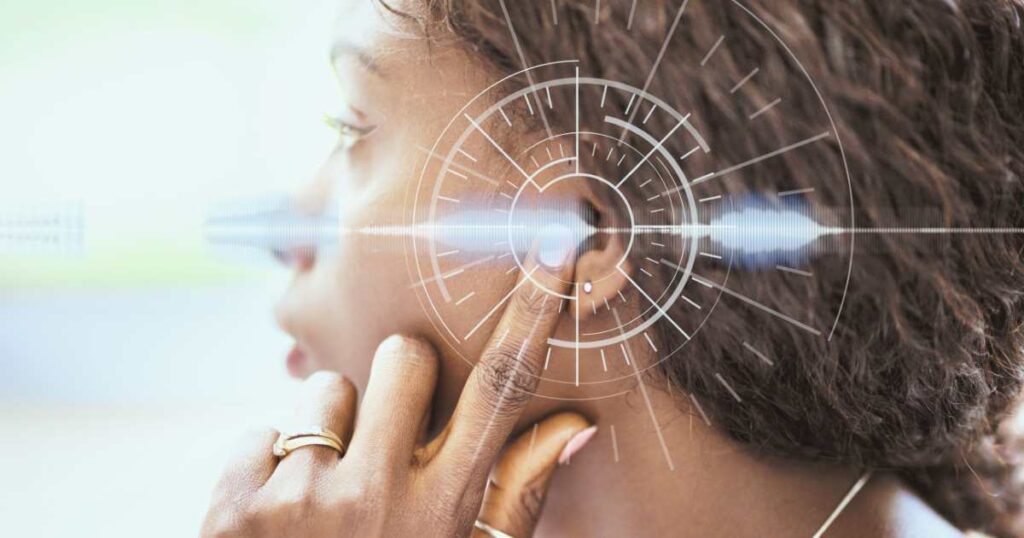
While the use of white noise is technically a form of tinnitus masking, formal tinnitus masking tends to involve more elaborate techniques, including frequency and intensity matching, continuous sound, individual adjustments, and adaptive sound technology.
Frequency Matching: The frequency of the masking sound is chosen to match the frequency of the tinnitus. Frequency matching helps ensure that the masking sound effectively covers the specific frequencies associated with the tinnitus perception.
Intensity Matching: The intensity or volume of the masking sound is adjusted to be equal to or slightly louder than the perceived loudness of the tinnitus. This is sometimes called “mixing point masking”. If it’s too loud, the masking sound might not allow for habituation.
Continuous Sound: Masking sounds are typically continuous, without abrupt changes or interruptions. Continuous sound helps create a consistent background, making it less likely for the brain to focus on the interruptions and more likely to habituate to the steady background noise.
Individualized Adjustments: Tinnitus masking often involves individualized adjustments based on the specific characteristics of the individual’s tinnitus, such as pitch and loudness. Customization ensures that the masking therapy is tailored to the unique features of the individual’s tinnitus.
Adaptive Sound Technology: Some advanced masking devices utilize adaptive sound technology, adjusting the characteristics of the masking sound based on the changing conditions of the tinnitus or the individual’s environment.
Partial vs. Total Tinnitus Masking
Partial tinnitus masking is where the person can still just barely hear the tinnitus sound over the masking sound. This is sometimes called the “mixing point”. Total tinnitus masking is when the masking sound completely blocks awareness of the tinnitus sound.
Certain schools of sound therapy (like Tinnitus Retraining Therapy) insist that partial masking is necessary. You must be able to hear the tinnitus sound in order to adapt to it and their whole treatment philosophy is based on this habituation to the tinnitus sound (learning to ignore it).
Tinnitus Suppression, Residual Inhibition, and the Rebound Effect
When inner ear cells die and hearing loss occurs, the hearing nerve is still alive and actually becomes hyperactive. What’s really cool is that when you listen to masking sounds, it actually decreases the firing rate of your tinnitus neurons.
With masking, your not just covering up the tinnitus sound, you effectively suppress tinnitus by physiologically decreasing the hyperactivity of your hearing nerve. This is called tinnitus suppression.
Once the masking sound is turned off, there is a period of relative silence when then tinnitus actually stops (that is, the hearing nerve stops firing). This is called residual inhibition and it occurs in 80% of people with tinnitus. This effect lasts only around 5 seconds, but it can be longer. In fact, the longer you listen to masking sounds, the longer the period of residual inhibition will be.
When residual inhibition ends, the hearing nerve goes back to its normal hyperactive state. After having a relative period of “quiet”, especially during the residual inhibition period, your tinnitus will actually sound louder. This side effect of masking is called the rebound effect. It’s not actually louder, it just seems that way because you got a brief reprieve.
To avoid the rebound effect, people should slowly decrease the masking sound over a couple of minutes, rather than abruptly stop it.
What are the different kinds of masking devices for tinnitus?
There are a variety of masking devices for tinnitus, treatment options ranging from simple white noise generators for self-directed therapy to custom ear-level devices dispensed by hearing professionals. Here are the most common forms of tinnitus masking devices:
| Masking Device | Description |
|---|---|
| White Noise Machines | These devices produce a consistent sound that covers a broad range of frequencies, helping mask the perceived tinnitus noise. Most white noise generators will include other options like nature sounds or ocean waves. |
| Mechanical Devices | Simple electric fans or air purifiers can provide a continuous and steady external noise that helps mask tinnitus. |
| Hearing Aids with Built-In Maskers | Some hearing devices come equipped with built-in sound generators that can produce a variety of sounds to help mask tinnitus. These are sometimes called “combination devices”. |
| Ear-Level Tinnitus Maskers | These specialized devices look like hearing devices but they are designed specifically to provide ear-level masking sounds. They’re typically used in chronic tinnitus management programs. |
| Sound Therapy Apps | Mobile applications that offer a variety of customizable sounds for tinnitus masking, often available on smartphones or tablets. Some apps like Beyond Tinnitus allow you to combine masking sounds with your favorite music. |
| Sleep Sound Machines | Devices designed to aid sleep by providing a variety of soothing sounds, which can also be used for tinnitus masking during nighttime. |
The best tinnitus masking device depends on the type of sound therapy that is being used and the personal preference of the user. More advanced methods of sound therapy typically involve working with an audiologist.
At NeuroMed, we developed a highly efficient way of providing formal masking files. We conduct the tinnitus matching through an online portal, so that you can do it from home. The output is a customized sound therapy file fit to your specific tinnitus profile.
We have a specific spectral sound strategy called “harmonic masking” that we developed that leads to superior tinnitus suppression. We tested this masking strategy in formal clinical trials and it was shown to be superior to white noise.

What is tinnitus notch therapy?
Tinnitus notch therapy, also known as notched sound therapy, is an approach that uses specifically modified or “notched” sound around the frequency of their tinnitus. A notched sound reduces the intensity of the sound around the frequency of the individual’s tinnitus, creating a “notch” in the audio spectrum.
The goal is to stimulate neural plasticity in the auditory system and induce habituation, reducing the perception and annoyance associated with tinnitus over time. We have not found notched sound to work effectively for patients. Some patients have worsening of tinnitus with notched sound.
What is Tinnitus Retraining Therapy?
Tinnitus Retraining Therapy (TRT) is a comprehensive approach to managing tinnitus that combines audiologist counseling and sound therapy. TRT is based on the neurophysiological model of tinnitus, focusing on the brain’s processing of tinnitus signals and emotional reactions to them. The key components of TRT include:
| TRT Component | Description |
|---|---|
| Audiological Evaluation | An audiologist assesses the individual’s hearing and tinnitus characteristics, identifying the pitch and loudness of the tinnitus. |
| Directive Counseling | Here, audiologist counseling aims to help them understand the neurophysiological processes involved in tinnitus perception and emotional reactions. This aims to reframe negative thoughts and beliefs about tinnitus. |
| Sound Therapy | TRT incorporates sound therapy, where individuals use low-level, neutral sounds (often delivered through noise generators or hearing aids with sound generators) to partially mask the tinnitus and promote habituation. |
| Long-Term Habituation | The primary goal of TRT is long-term habituation to the perception of tinnitus. This involves helping individuals become less aware of their tinnitus and reducing the emotional distress associated with it. |
TRT is based on the idea that individuals can habituate to tinnitus by both reducing the brain’s sensitivity to the tinnitus signal and changing emotional reactions through counseling. The success rate of TRT is around 80% but the program takes 1-2 years with a cost of $5000 or above.
What is tinnitus habituation?
Tinnitus habituation refers to the process by which an individual learns to tolerate the presence of tinnitus without it causing significant anxiety or stress. Through habituation, the perception of tinnitus becomes less salient (important), and the emotional and psychological reactions to the sound diminish.
The concept of habituation is central to tinnitus retraining therapy. Habituation is based on the brain’s ability to adapt to constant or repetitive stimuli over time. In the case of tinnitus, the initial perception of the sound may trigger heightened awareness, anxiety, stress or annoyance. However, with time and consistent exposure to the sound, the brain can learn to filter out or down regulate the significance of the tinnitus signal.
One technical point about habituation is that the auditory stimulus from masking must be low enough so that you can just slightly hear the tinnitus sound. This is “the mixing point” referred to above.
What’s the difference between Cognitive Behavioral Therapy and Tinnitus Retraining Therapy?
Cognitive behavioral therapy (CBT) for tinnitus and TRT are very similar, but there are some differences. CBT offers more advanced psychological tools whereas TRT is mostly support from an audiologist combined with education on the auditory system. CBT may or many not use sound therapy, but TRT absolutely relies on it.
What does Tinnitus Retraining Therapy cost?
Tinnitus Retraining Therapy tends to be expensive because it involves around 10 clinical visits and typically requires the purchase of ear-level tinnitus masking devices. The total cost is approximately $3000-$7000 depending on where you live.
What is bimodal stimulation for tinnitus?
Bimodal stimulation for tinnitus combines tinnitus sound therapy with another form of sensory input, such as electrical or tactile stimulation. The goal of this is to modulate neural activity in the auditory system and influence the perception of tinnitus.
Examples of bimodal stimulation include the Lenire device, which combines tinnitus sound therapy with tongue vibration, and the Neosensory device, which combines tinnitus sound therapy with wrist vibration.
At this point, it remains unclear whether bimodal stimulation for tinnitus is any better than standard sound therapy for tinnitus. In our experience, we have yet to see a patient who had significant improvement from the Lenire device. Based on their own studies, the improvement in tinnitus is no more than standard sound therapy alone. My advice is save yourself $6000 and don’t get it.
What is structured sound therapy for tinnitus at NeuroMed?
When we speak of structured sound therapy and prescribe it to our patients as part of the NeuroMed program, here’s what we mean:
- Sessions should be daily and regular.
- Sessions should last around 2 hours a day.
- Sound therapy files should be set at the “mixing point” (when it just barely masks the tinnitus sound).
- Patients should be mindful to slowly lower the masking sound in the last 2-3 minutes of each session.
- When not in a sound therapy session, people should try to have a noise-enriched environment (something like an air purifier, white noise generator, etc, in the background).
At NeuroMed, we give the option of using an online customized sound therapy file for this (BeyondTinnitus.com), but this is not essential as white noise or brown noise will do. What’s really important is that the sessions are daily and regular.
Can sound therapy cure tinnitus?

While tinnitus sound therapy will not cure ringing in the ears, it is a very effective tool for managing and reducing the perceived loudness of tinnitus, promoting habituation, and improving overall quality of life for individuals living with chronic ear ringing.
The philosophy behind TRT is correct, in my opinion. The neurophysiological model of tinnitus explains the perception of tinnitus based on changes in the central auditory system of the brain. This means that tinnitus is a result of maladaptive neuroplastic changes and that successful treatment requires a rewiring process in the brain.
Where TRT falls short is that it focuses solely on the tinnitus sound and not the other factors that drive tinnitus. Research in my academic clinic has shown that loud tinnitus is related to a migraine-like phenomenon in the brain. Without addressing this, there is only so much that tinnitus sound therapy can do. This same critique is true for devices that deliver bimodal stimulation for tinnitus.
On the other hand, by integrating tinnitus sound therapy into a more comprehensive rehabilitation strategy that addresses the migraine issue, we are able to achieve higher success rates, and most often, in a shorter period of time.
Conclusion: With sound therapy, tinnitus gets better!
Sound therapy for tinnitus management is a critical tool that can provide significant relief. While no single sound therapy technique is universally endorsed, its consistent positive impact underscores its role in comprehensive tinnitus rehabilitation.
Recognizing the exacerbation of tinnitus in silence, sound therapy offers relief by masking or distracting from internal noise, emphasizing its importance in quiet environments and during nighttime.
While sound therapy doesn’t cure tinnitus, integrating it into a comprehensive approach enhances treatment success rates. For tinnitus patients, sound therapy remains a key element in improving tinnitus, stress management, and overall well-being.




